Coins of Castile and Leon - catalog with values
Kingdom of Castile and Leon
dinero
Alfonso X (1252-1284)
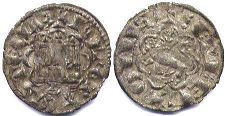
noven (9 dinero) no date
silver
MONETA CASTELLE
ET LEGIONS
Coin value ~ 25-30 USD

maravedi "black" (1/2 maravedi) no date
billon
ALF REX CASELL
ET LEGIONIS
Coin value ~ 20-25 USD
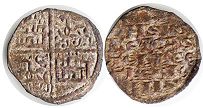
dinero no date
billon
ALFONSVS REX CASTELLE ETLEGIONIS
Coin value ~ 10-15 USD

obol (1/2 dinero) no date
billon
LEGIONIS
CASTELLE
Coin value ~ 10-15 USD
Sancho IV (1284-1295)
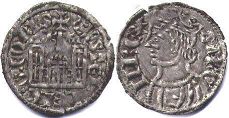
cornado noven (9 dinero) no date
billon
CASTELLE LE GIONIS
SANC II REX
Coin value ~ 30-35 USD
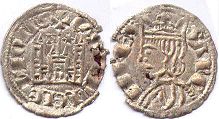
cornado noven (9 dinero) no date
billon
CASTELLE LE GIONIS
SANC II REX
Coin value ~ 30-35 USD
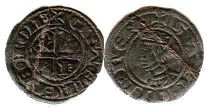
cornado seisen (6 dinero) no date
billon
CASTELLE LEGION
SANCII REX
Coin value ~ 30-35 USD
Ferdinand (Fernando) IV (1295-1312)
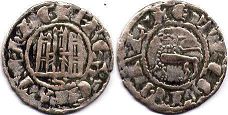
pepion (dinero) no date
billon
F REX CASTELLE
ET LEGIONIS
Coin value ~ 15-20 USD
Alfonso XI (1312-1350)
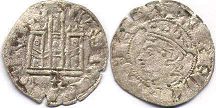
cornado noven (9 dinero) no date
billon
CASTELE LEGIONIS
ALFONSVS DO GRA R
Coin value ~ 25-30 USD
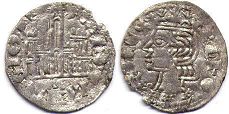
cornado noven (9 dinero) no date
billon
CASTELE ET LEGIONIS
ALFONS REX
Coin value ~ 25-30 USD
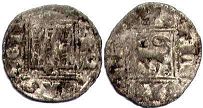
noven (9 dinero) no date
billon
ALF REX CASTELLE
ET LEGIONIS
Coin value ~ 10-15 USD
Henry (Henrique) II Trastamara (1366-1367 and 1369-1379)
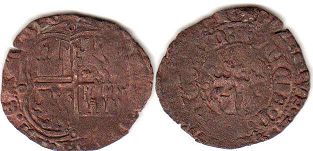
3 maravedis no date
billon
DOMINVS MIHI ADIVTOR ET EGO DI PISCAN INIMICOS MEOS / E N
ENRICVS REX CASTELLE E LEGIONIS
Coin value ~ 30-35 USD
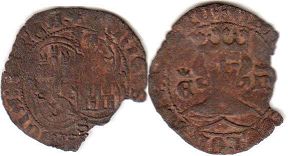
1/2 maravedi
billon
ENRICVS DEI GRACIA REX CASTE
ENRICVS DEI GRACIA REX CASTE / E N
Coin value ~ 30-35 USD
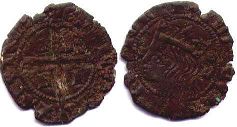
cruzado (10 dinero) no date
billon
ENRICVS REX CASTELLE / ENRI
ENRICVS REX LEGIONIS
Coin value ~ 15-20 USD
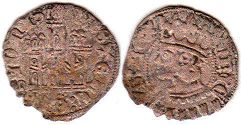
cornado (9 dinero) no date
billon
CASTELE E LEGIONI
ENRICVS REX
Coin value ~ 15-20 USD
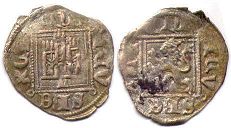
noven (9 dinero) no date
billon
ENRICVS REX C
ENRICVS REX C
Coin value ~ 15-20 USD
John (Juan) I (1379-1390)
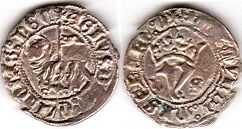
blanca (1/4 real) no date
silver
AGNVS DEI QVI TOLIS PEC
CATA MVNDI MISERERE NOBIS
Coin value ~ 35-45 USD
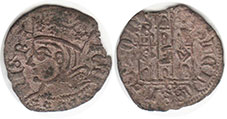
cornado (9 dinero) no date
billon
IOHANIS REX
CASTELE E LEGIONI
Coin value ~ 30-40 USD
Maravedi=2 dinero; Blanca=4 dinero
Henry (Henrique) III (1390-1406)
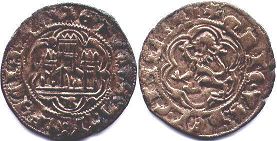
blanca no date
billon
ENRICVS DEI GRACIA REX
ENRICVS DEI GRACIA REX
Coin value ~ 20-25 USD
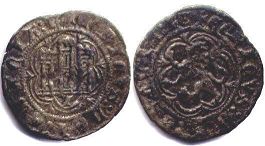
blanca no date
billon
ENRICVS DEI GRACIA
ENRICVS DEI GRACIA RE
Coin value ~ 15-20 USD
John (Juan) II (1406-1454)
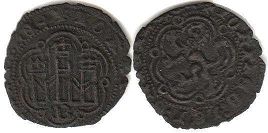
blanca no date
billon
IOHANES DEI GRACIA REX
IOHANES DEI GRACIA REX CA
Coin value ~ 15-20 USD
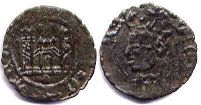
cornado nuevo (1/2 blanca) no date
billon
IOHANES DEI GRACIA
IOHANES DEI GR
Coin value ~ 15-20 USD
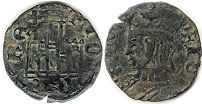
cornado nuevo (1/2 blanca) no date
billon
IOHANESREX
IOHANES DEI GR
Coin value ~ 15-20 USD
Henry (Henrique) IV (1454-1474)
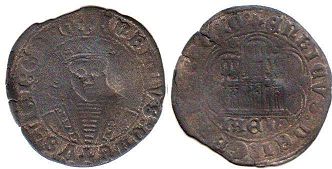
Quartillo (1/4 real=8,5 maravedi) no date
billon
ENRICVSCARTVSDEI GRA
ENRICVSDEI GRA REX C / IAEN
Coin value ~ 40-50 USD
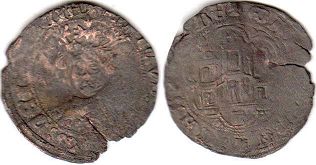
Quartillo (1/4 real=8,5 maravedi) no date
billon
ENRICVSCARTVSDEI GRACIA
ENRICVS REX CASTELLE
Coin value ~ 35-40 USD
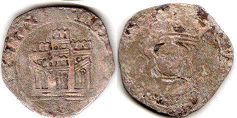
1/2 quartillo no date
billon
ENRICVS DEI GRACIA REX
ENRICVS QVARTVS REX CAS
Coin value ~ 25-30 USD
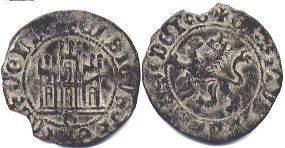
2 maravedi no date
billon
ENRICVS REX CASTELLI
ENRICVS CARTVS DEI G
Coin value ~ 40-50 USD
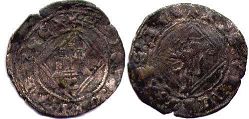
dinero no date
billon
ENRICVS DEI GRA REX
XPS VINCIT XPS REG
Coin value ~ 10-15 USD
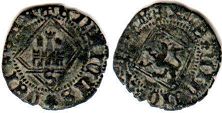
dinero no date
billon
ENRICVS DEI GRACIA
XPS VINCIT XPS
Coin value ~ 10-15 USD
Real=34 maravedi; Maravedi=2 blanca
Isabella I and Ferdinand V (1479-1504)
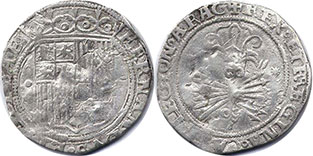
1 real no date
silver
FERNANDVS ET ELISABET
REX ET REGINA CASTELE GION AR
Coin value ~ 50-60 USD
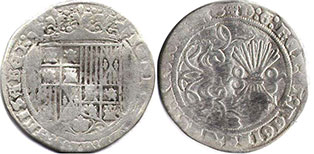
1 real no date
silver
FERNANDVS ET ELISABET
D G REX ET REGINA CASTELE GION AR
Coin value ~ 50-60 USD
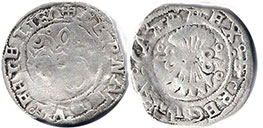
1/2 real no date
silver
FERNANDVS ET ELISABET
REX ET REGINA CASTELE GION AR
Coin value ~ 50-60 USD
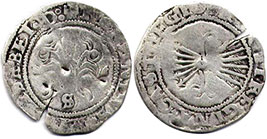
1/2 real no date
silver
FERNANDVS ET ELISABET D
REX ET REGINA CASTEL GION AR
Coin value ~ 50-60 USD
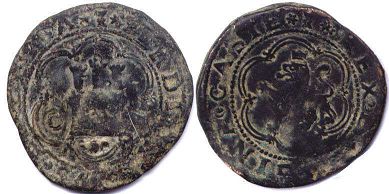
4 maravedi no date
copper
FERDINAND ET ELISABET
REX ET REGINA CASTE
Coin value ~ 25-30 USD
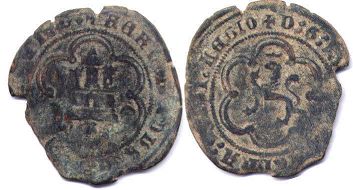
4 maravedi no date
copper
FERNANDVS ET ELISABET
D G REX ET REGINA CAST LEGIO
Coin value ~ 30-40 USD
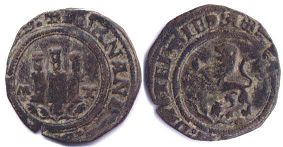
2 maravedi no date
copper
FERNANDVS ET ELISABET
D G REX ET REGINA CASTEL E LEG
Coin value ~ 15-20 USD
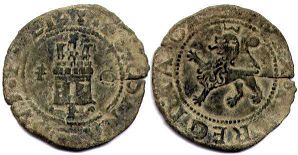
2 maravedi no date
copper
FERNANDVS ET ELISABET
REX ET REGINA CAST LEGION
Coin value ~ 20-25 USD
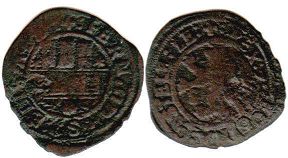
2 maravedi no date
copper
FERNANDVS ELISABET
REX ET REGINA CASTELE LE
Coin value ~ 15-20 USD
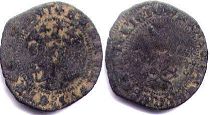
1 maravedi no date
copper
FERNANDVS ET ELISABET
REX ET REGINA CASTEL GION
Coin value ~ 15-20 USD
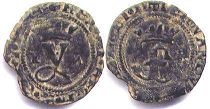
1 blanca no date
copper
Coin value ~ 10-15 USD
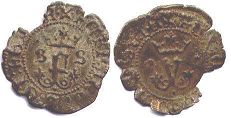
1 blanca no date
copper
Coin value ~ 10-15 USD
Coins of other Spanish States
Costs of Castile and Leon coins in this catalog approximate and indicated specifically for the coin shown in the picture.
I do not buy or sell coins - this is just a catalog.

